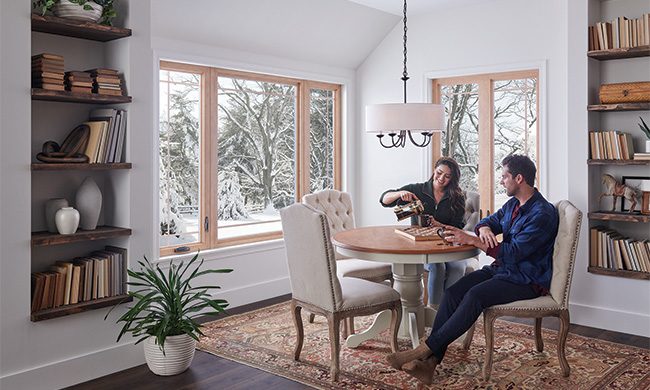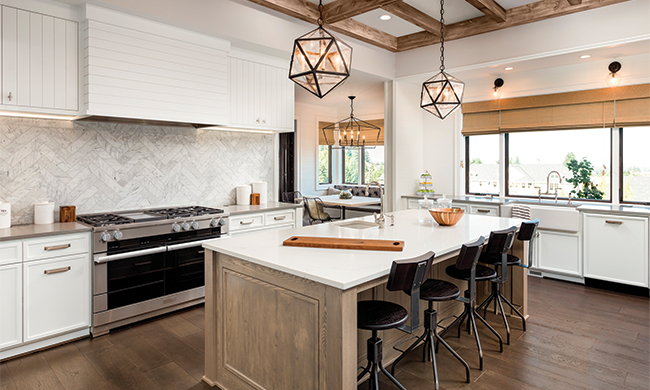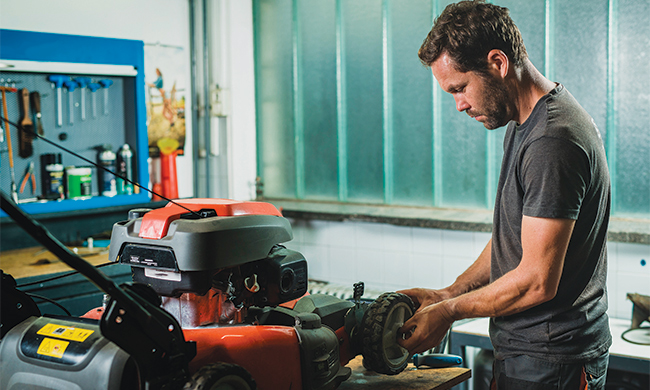home improvement
Declutter Bathrooms in 6 Simple Steps
Last Updated on September 24, 2025 by Daily News Staff
Declutter Bathrooms in 6 Simple Steps
(Family Features) Due to their small size and heavy usage, bathrooms can become messy, cluttered areas for many families.
For those with smaller bathrooms, storage solutions can be even harder to find. Consider these organization tips to make your bathroom a clean and functional space for every member of the family:
Assess the mess: Go through all the cabinets and drawers to clear out unused makeup, health care products and medications. Make sure the items you keep are used on a regular basis. Items used sparingly should be placed in an alternate location.
Go vertical: Medicine cabinets can quickly get stuffed when combs, toothpaste and other toiletries are stored horizontally. Use organizer cups with suction adhesives to contain items vertically and save space.
Hang up in style: Old coat racks and ladders make perfect solutions for larger families to hang multiple towels. Snag an old one from a thrift store and paint it a bright hue, like red or turquoise, for a stylish bathroom accent piece.
Avoid spills and squirts: Hair products, such as gels, mousses or hairsprays, can create sticky, tough-to-clean messes if liquid escapes the container in a drawer or cabinet. Avoid such mishaps by placing these types of items in plastic tubs instead of directly in the drawer or on a shelf.
Divide and conquer: Bathroom drawers can become unruly if not organized. To keep items separate and tidy, insert dividers, such as those used for kitchen utensils. These often come in fun materials, such as bamboo or stainless steel, to add a fresh look.
Assign cabinets or drawers: Try to use a large enough cabinet so each member of the family has his or her own space or drawer. This can help limit the amount of items high-maintenance family members can bring into the small area. Plus, it makes it easier for everyone to find their things.
Find more tips to transform your bathroom into a clean, organized environment, regardless of its size, at eLivingtoday.com.
Photo courtesy of Unsplash
SOURCE:
Family Features
Discover more from Daily News
Subscribe to get the latest posts sent to your email.
Consumer Corner
Cold Weather Home Comfort Hacks
Stay warm and save money with these cold weather home comfort hacks. From smart thermostats to energy-efficient windows, discover 6 upgrades that boost comfort and cut heating costs this winter.

Cold Weather Home Comfort Hacks
(Family Features) As temperatures drop and cozy season sets in, keeping your home comfortable doesn’t mean undergoing a full-scale renovation. In fact, with a few smart upgrades, you can create a warm, inviting space – while improving your home’s energy efficiency, too. Before the chill sets in, consider these cool-weather comfort hacks, inspired by the experts at Simonton Windows & Doors, who have delivered high-quality replacement windows and patio doors designed to enhance the appearance, security and comfort of homes around the country for more than 75 years. Install a Smart Thermostat One of the easiest ways to increase comfort while also reducing heating costs, installing a smart thermostat allows for automatic temperature adjustment, keeping your home warm while it’s occupied and conserving energy when you’re away. Over time, these intelligent devices learn your schedule and habits, and can be controlled remotely from a smartphone to let you turn on the heat prior to arriving back at home. Replace Older Windows If your windows are drafty or difficult to open, it may be time to upgrade. Modern replacement windows can dramatically improve energy efficiency and insulation. High-quality options from Simonton, including DaylightMax and 6200 Sliding Windows and 5500 and 6500 Double Hung Windows, meet the highest standards of performance and reliability, having successfully earned the prestigious Good Housekeeping Seal following rigorous testing. Designed with security and weather resistance in mind, these windows are known for their durability, wide range of styles and advanced energy-saving features. “This is a testament to the unwavering commitment we have to bring the best products to building professionals and homeowners,” said Kate Land, vice president of product and innovation at Cornerstone Building Brands, parent company of Simonton. “For more than 75 years, the Simonton brand has given homeowners confidence that they are investing in windows that truly deliver the highest quality and performance. This recognition solidifies our place as an industry leader customers can rely on.” Add Insulating Window Treatments Window treatments can do more than just add a design element to your home’s interior. Options like layered drapes, thermal curtains or cellular shades can help reduce heat loss. Remember to open your curtains or blinds during the day to let in natural light and close them at night to trap warmth and keep your spaces comfortable. This can also help circulate the air in your home and reduce the chances of condensation on your windows when the temperature dips. Seal Gaps and Keep Weatherstripping Clean Even the smallest of gaps around windows or doors can allow cold air to seep in. Check weatherstripping for wear and tear, replace as needed and use expandable foam or caulk to seal large gaps. Keeping the areas around doors and windows clean can also help maintain a tight seal and prevent winter’s chill from invading your comfortable space. Upgrade Patio Doors Old or inefficient patio doors can let in drafts and drive up energy bills. Replacing them with energy-efficient models, such as Simonton Contemporary Sliding Patio Doors, can help maintain comfort and enhance your home’s appearance. Fully customizable with a wide range of colors, interior woodgrains and hardware finishes, the doors are designed with a narrow frame for more natural light without sacrificing energy efficiency. Plus, optional high-density SmartCore foam can further improve thermal efficiency, allowing you to enjoy winter’s beauty from the comfort of the indoors. Add Insulation Inspect your attic, basement, garage and crawl spaces for spots where insulation may be lacking. An easy and affordable way to retain heat and improve efficiency, adding pre-cut insulation into bays between ceiling joists or blowing in loose-fill insulation over the existing layer can help keep your home warmer all season long. By making a few smart upgrades and prepping your space for the cold weather ahead, you can maximize comfort and energy efficiency. To ensure your home stays comfortable this winter and beyond, visit simonton.com for more solutions.
Replace Older Windows If your windows are drafty or difficult to open, it may be time to upgrade. Modern replacement windows can dramatically improve energy efficiency and insulation. High-quality options from Simonton, including DaylightMax and 6200 Sliding Windows and 5500 and 6500 Double Hung Windows, meet the highest standards of performance and reliability, having successfully earned the prestigious Good Housekeeping Seal following rigorous testing. Designed with security and weather resistance in mind, these windows are known for their durability, wide range of styles and advanced energy-saving features. “This is a testament to the unwavering commitment we have to bring the best products to building professionals and homeowners,” said Kate Land, vice president of product and innovation at Cornerstone Building Brands, parent company of Simonton. “For more than 75 years, the Simonton brand has given homeowners confidence that they are investing in windows that truly deliver the highest quality and performance. This recognition solidifies our place as an industry leader customers can rely on.” Add Insulating Window Treatments Window treatments can do more than just add a design element to your home’s interior. Options like layered drapes, thermal curtains or cellular shades can help reduce heat loss. Remember to open your curtains or blinds during the day to let in natural light and close them at night to trap warmth and keep your spaces comfortable. This can also help circulate the air in your home and reduce the chances of condensation on your windows when the temperature dips. Seal Gaps and Keep Weatherstripping Clean Even the smallest of gaps around windows or doors can allow cold air to seep in. Check weatherstripping for wear and tear, replace as needed and use expandable foam or caulk to seal large gaps. Keeping the areas around doors and windows clean can also help maintain a tight seal and prevent winter’s chill from invading your comfortable space. Upgrade Patio Doors Old or inefficient patio doors can let in drafts and drive up energy bills. Replacing them with energy-efficient models, such as Simonton Contemporary Sliding Patio Doors, can help maintain comfort and enhance your home’s appearance. Fully customizable with a wide range of colors, interior woodgrains and hardware finishes, the doors are designed with a narrow frame for more natural light without sacrificing energy efficiency. Plus, optional high-density SmartCore foam can further improve thermal efficiency, allowing you to enjoy winter’s beauty from the comfort of the indoors. Add Insulation Inspect your attic, basement, garage and crawl spaces for spots where insulation may be lacking. An easy and affordable way to retain heat and improve efficiency, adding pre-cut insulation into bays between ceiling joists or blowing in loose-fill insulation over the existing layer can help keep your home warmer all season long. By making a few smart upgrades and prepping your space for the cold weather ahead, you can maximize comfort and energy efficiency. To ensure your home stays comfortable this winter and beyond, visit simonton.com for more solutions. Welcome to the Consumer Corner section of STM Daily News, your ultimate destination for savvy shopping and informed decision-making! Dive into a treasure trove of insights and reviews covering everything from the hottest toys that spark joy in your little ones to the latest electronic gadgets that simplify your life. Explore our comprehensive guides on stylish home furnishings, discover smart tips for buying a home or enhancing your living space with creative improvement ideas, and get the lowdown on the best cars through our detailed auto reviews. Whether you’re making a major purchase or simply seeking inspiration, the Consumer Corner is here to empower you every step of the way—unlock the keys to becoming a smarter consumer today!
https://stmdailynews.com/category/consumer-corner/
Discover more from Daily News
Subscribe to get the latest posts sent to your email.
Consumer Corner
Kitchen Lighting Ideas: Transform Your Space with Smart Upgrades and LED Solutions
ransform your kitchen with practical lighting upgrades. Learn how to create layered lighting with ambient, task, and accent lights, choose energy-efficient LED bulbs, select statement fixtures, and add smart controls for a functional, stylish space.

Transform Your Kitchen with Lighting Upgrades
(Family Features) As the heart of many homes, the kitchen is often for much more than cooking. From morning coffee and gathering for family meals after long days at school and the office to entertaining loved ones on the weekend, functional, stylish lighting can make your kitchen truly shine – day or night. Whether you’re planning a full-scale remodel or simply looking to refresh one of your most-used spaces, even modest lighting updates can enhance its aesthetic appeal and usability. From swapping out lightbulbs to replacing fixtures, adding smart controls and more, these ideas can help you brighten things up. Add Balance with Layered Lighting The most well-lit kitchens incorporate three layers of lighting: ambient, task and accent. Ambient lighting, typically from recessed ceiling lights or a centralized light fixture, provides general illumination and sets the tone for the space. Task lighting, such as under-cabinet light strips or a hanging fixture above an island, provides focused light over work zones like the sink, stove or countertops. Finally, accent lights in cabinets, baseboards or backsplash can add depth and drama, for a practical and inviting layered look. Upgrade to Energy-Efficient Lightbulbs One of the simplest ways to upgrade your kitchen – or any room – is swapping old lightbulbs for energy-efficient LED bulbs. From cozy warm whites to bright white and amber hues, LEDs come in a variety of color temperatures to fit your space. Plus, they typically last longer and use less energy than halogen, incandescent and fluorescent bulbs and they’re often dimmable, giving homeowners complete control over the space’s brightness and mood. Make a Statement with New Fixtures A design feature all their own, lighting fixtures like chandeliers or pendants over the kitchen table or center island can instantly elevate your kitchen’s look and feel. For a sleek, modern aesthetic, consider polished chrome finishes; think brass or brushed nickel for warmth; or opt for matte black for stunning contrast. Remember to look for fixtures in finishes that complement your appliances and cabinet hardware to truly bring the space together. Embrace Smart Technology Even small updates can make a big difference when it comes to bringing your kitchen into the future. Swapping out old switches with smart options that allow you to adjust brightness throughout the day, schedule your lights to turn on or off automatically and change the color temperature from your smartphone or voice assistant can enhance usability and convenience while reducing energy usage. Find more ideas to enhance your living spaces at eLivingtoday.com. Photo courtesy of ShutterstockWelcome to the Consumer Corner section of STM Daily News, your ultimate destination for savvy shopping and informed decision-making! Dive into a treasure trove of insights and reviews covering everything from the hottest toys that spark joy in your little ones to the latest electronic gadgets that simplify your life. Explore our comprehensive guides on stylish home furnishings, discover smart tips for buying a home or enhancing your living space with creative improvement ideas, and get the lowdown on the best cars through our detailed auto reviews. Whether you’re making a major purchase or simply seeking inspiration, the Consumer Corner is here to empower you every step of the way—unlock the keys to becoming a smarter consumer today!
https://stmdailynews.com/category/consumer-corner
STM Daily News is a multifaceted podcast that explores a wide range of topics, from life and consumer issues to the latest in food and beverage trends. Our discussions dive into the realms of science, covering everything from space and Earth to nature, artificial intelligence, and astronomy. We also celebrate the amateur sports scene, highlighting local athletes and events, including our special segment on senior Pickleball, where we report on the latest happenings in this exciting community. With our diverse content, STM Daily News aims to inform, entertain, and engage listeners, providing a comprehensive look at the issues that matter most in our daily lives. https://stories-this-moment.castos.com/
Discover more from Daily News
Subscribe to get the latest posts sent to your email.
home improvement
How-To Winterize Your Lawn Mower
Winterize Your Lawn Mower: As mowing season winds down with cooler weather setting in, it’s time to prepare your lawn mower for storage. Properly winterizing your mower can help ensure it’s ready to run smoothly when spring returns.
Last Updated on December 3, 2025 by Daily News Staff

How-To Winterize Your Lawn Mower
(Family Features) As mowing season winds down with cooler weather setting in, it’s time to prepare your lawn mower for storage. Properly winterizing your mower can help ensure it’s ready to run smoothly when spring returns. Consider these steps to get your mower ready for winter, which may help prevent corrosion, fuel problems and more costly repairs. Clean Your Mower Thoroughly Start by removing any loose grass clippings, dirt and debris then, using a garden hose and scraper, clean the underside of the mower deck. Wipe down the exterior with a damp cloth and mild soap or all-purpose cleaner. Once dry, apply a light coat of silicone spray to metal parts to help prevent rust. Drain or Stabilize the Fuel Gasoline left in the tank through winter can break down and cause carburetor issues. You can either drain the tank by running the mower until it’s out of fuel or add fuel stabilizer, running your mower for 5-10 minutes afterward to circulate it through the fuel system. Change the Oil Similarly, used oil contains contaminants that can corrode your mower’s engine. Drain the oil following your mower’s manual – usually by tipping the mower or removing the drain plug – then refill with the recommended type and amount of fresh oil. Inspect the Spark Plug To inspect for buildup or wear, remove the sparkplug then gently clean with a wire brush. If corroded or worn, the sparkplug may need replaced. Clean or Replace the Air Filter A clean air filter helps your mower run more efficiently. Replace paper filters or wash foam filters in warm, soapy water before drying and lightly oiling then reinstalling. Sharpen the Blade Remove the mower blade and inspect it for nicks or dull edges. If necessary, sharpen it using a file or grinder then reinstall securely. Lubricate Moving Parts Apply spray lubricant to moving parts, such as the wheels, cables and pivot points, to prevent rust and sticking. Find more guidance for keeping your lawn equipment working correctly at eLivingtoday.com. Photo courtesy of ShutterstockWelcome to the Consumer Corner section of STM Daily News, your ultimate destination for savvy shopping and informed decision-making! Dive into a treasure trove of insights and reviews covering everything from the hottest toys that spark joy in your little ones to the latest electronic gadgets that simplify your life. Explore our comprehensive guides on stylish home furnishings, discover smart tips for buying a home or enhancing your living space with creative improvement ideas, and get the lowdown on the best cars through our detailed auto reviews. Whether you’re making a major purchase or simply seeking inspiration, the Consumer Corner is here to empower you every step of the way—unlock the keys to becoming a smarter consumer today!
https://stmdailynews.com/category/consumer-corner/
Discover more from Daily News
Subscribe to get the latest posts sent to your email.

